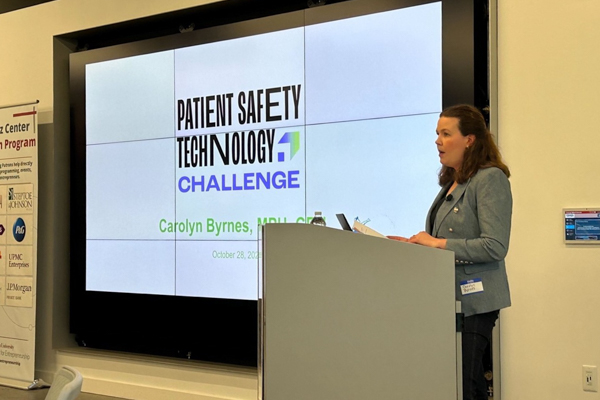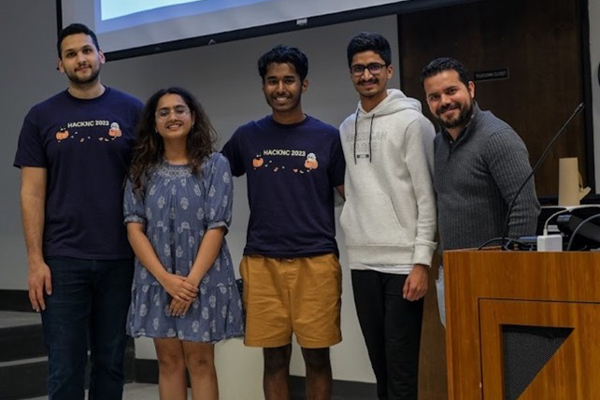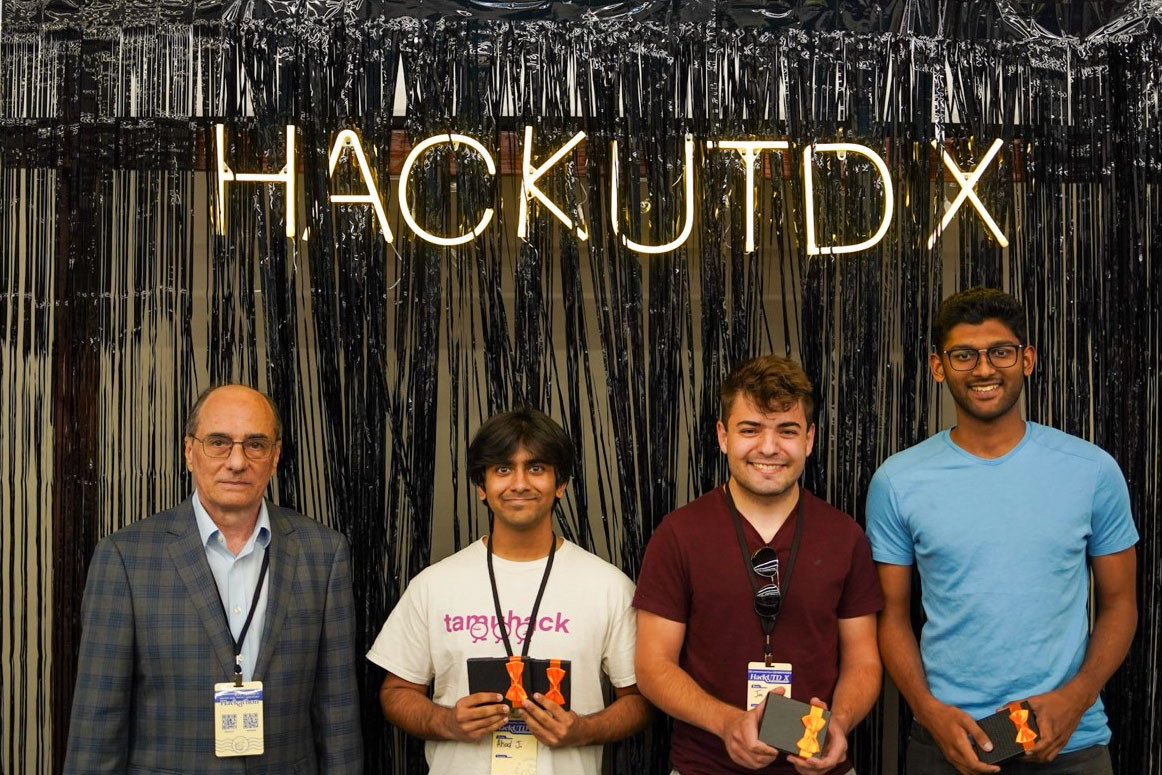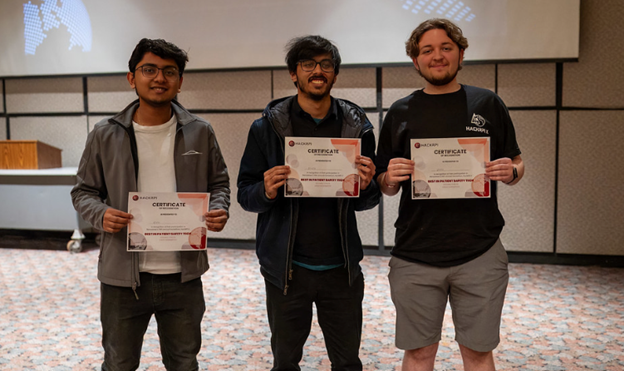Project & Program Updates
November Boasts Record-Setting Number of Patient Safety Innovations and Awards
The Patient Safety Technology Challenge announced the winners of the 12 sponsored events that took place since the last week of October, the greatest number of awards for patient safety technology innovation ever in a four-week period.
Hack-a-Startup is Carnegie Mellon University Swartz Center of Entrepreneurship's two-week immersive experience encouraging students to create a start-up on an accelerated timeframe. Teams were incentivized by three general prizes for the best start-up ideas, and a fourth special prize was sponsored by the Patient Safety Technology Challenge to award the best tech-enabled patient safety solution. The event kicked-off on October 28th with a workshop on patient safety. Several other workshops were offered from October 30 to November 10 to foster the beginning stages of CMU students' startups. The winner was SafeRx who had recently also taken home the grand prize from hackAuton on CMU's campus. They focused on creating a mechanism for physicians to assess adverse drug reactions, before they occurred using natural language processing, computer vision, and AI models.
SymptoSecure received the $400 prize as the winner of the "Best Patient Safety Hack" at this year's HackNC, a hackathon held on October 27-29 at the University of North Carolina Chapel Hill. Their prototype, SymptoSecure Plus, is a medical profiling tool intended to close the gap between patients and healthcare providers, with a specific emphasis on tackling healthcare disparities experienced by marginalized communities. The digital pre-consultation platform will assist patients in arranging and conveying their medical history, symptoms, and relevant information in a well-structured format.
The 10th Annual VandyHacks 24-hour hackathon was held at Vanderbilt University in Nashville, Tennessee on October 28-29.AEyes, a computer vision cross-platform mobile app for the visually impaired won the $500 prize for the best patient safety technology solution. The team was motivated by their friends who are visually impaired. They aimed to create a more accessible way for the visually impaired to get feedback about their surroundings since smart glasses can be expensive. Their app acts as the eyes of a person and takes an image of their surroundings to better understand the environment around them and tells the user, using AI-based text-to-speech, what is around them that could be hazardous. For example, the prototype shared with the judges showed when there was water on the ground – a slip hazard – or when they were approaching a staircase. The judges felt that this technology could be particularly useful in healthcare settings.
This year's HackSC-X was held at the University of Southern California on November 4-5 with the patient safety vertical receiving the most submissions. A total of 19 were judged to receive Amazon Gift cards worth $1,400 for the team to share. MedVisi-on was awarded with the best patient safety technology at HackSC-X. MedVisio-on acts as a supplementary cognitive resource and additional set of eyes for perioperative nurses, allowing them to better monitor equipment to alleviate their mental workload and enabling them to concentrate on the surgical procedure. Simultaneously, it was designed to diminish the avoidable risk of Retained Surgical Bodies, like scalpels and sponges.
The Patient Safety Technology Challenge track winning team received $400. The overarching theme of the hackathon was nautical-themed; therefore, hackers were encouraged to weave that theme into their projects. Man Overboard, the winning team, focused on a safety system crafted to identify passengers going "overboard," promptly alerting ship crews in real-time. Employing computer vision and instantaneous communication, their system consistently surveils the ship's surroundings, promptly notifying the crew upon detecting a potential overboard situation. The two patient safety judges, Linda Curley of Rutgers School of Nursing and Joan Gleason Scott of the New Jersey Hospital Association, thought this could easily be applied in healthcare settings. For example, it could be adjusted to track patients in nursing homes – a population that can easily go missing, or in pediatric hospital units to track children moving about the ward.
MakeUC is a hackathon weekend hosted annually at the University of Cincinnati's 1819 Innovation Hub. This year, a $500 prize was given to ManagMed for the best tech-enabled patient safety solution. The team created ManagMed, a consumer-facing mobile app focused on medication safety for patients to use after they visit their doctor. The app would help patients: look up their insurance coverage for new medications and provide suggestions for generic alternatives, set up reminders to take medications based on information gathered from scanning medication labels, alert them about drug interactions, and embed a chatbot to answer generic health questions after leaving the doctor's office.
HackUTD was held at the University of Texas at Dallas on November 4-5. Team members from Curis took home $1,000 as the winner of the Patient Safety Technology Track.Curis is a project focused on keeping oncologists updated on the optimal course of action for their patients. The AI-powered tool can also identify pertinent medical trials tailored to the individual patient's needs based on matching algorithms they created. The team's solution has the promise of enhanced diagnosis – reducing the risk of wrong or delayed diagnosis – which can be the difference between life and death for cancer patients.
OSU Bio-Hack hosted by Ohio State's Biomedical Engineering Society held its 5th annual event November 4-5. The theme of this year's hackathon was patient safety, so all 60 hackers were tasked to come up with a tech-enabled solution. The winning team took home $500 for their solution which helps emergency medical services (EMS) teams respond to the scene of an accident to score concussions. With the capability to be used offline, the solution is especially useful for rural settings. The team member who conceived this idea was an athletic trainer who frequently saw concussions in remote areas where patients needed to be assessed quickly. The device could also send a printout to the local emergency department to facilitate communication of the findings in the field. The athletic trainer and his team built a very simple device, running on a raspberry pi, with their custom software that made this a reality. The judge, Kevin Jones, from OSU, who works in Enterprise Architecture and Health Systems Informatics, thought it was a simple but very effective tool.
HackRPI was held at Rensselaer Polytechnic Institute on November 4-5. RPillPal: A Biometric Pill Dispenser was the winning patient safety team who took home the $1,000 prize. RPillPal was conceived as a potential solution to avoid opioid overdoses after patients are discharged from the hospital and ensure only the patient has access to that medication in order to protect other family members from having access to potentially harmful medications. Their prototype for the biometric pill dispenser is intended for home use and uses fingerprints for patient identification, providing accurate doses per doctor recommendations. It also allows for direct connectivity with healthcare providers to facilitate progress monitoring and timely treatment adjustments. The judge, Kathy Rauch, a nurse by background working for the Hospital Association of New York State, was impressed by the progress made by RPillPal during the 24-hour hackathon.
ASU's Social Innovation Start-up Lab – a course for graduate students from Arizona State University – wrapped up on November 16th with the seven student teams pitching to a panel of judges. The partnership between the Patient Safety Technology Challenge and this pitch competition was unique. Funding was not provided by the Pittsburgh Regional Health Initiative, instead the course professors invited Ariana Longley, project manager of the PSTC, to pitch patient safety as a topic for the students in their course to tackle. One team, NurseWav, formed and received support from Longley throughout the fall semester – focused primarily on directing them to subject matter experts that could help them with understanding the problem, and with customer discovery. Their solution focused on coming up with a tech-enabled solution to address alarm fatigue for nurses in non-acute post-surgery units in hospitals. In the end, NurseWav and one other team, FinEdu, split the grand prize of $5,000 equally. NurseWav will use the $2,500 they won from the pitch competition to continue working on their project.
A semester-long project at ASU's Edson College of Nursing and Health Innovation culminated at the Health Innovation Exhibition November 17. Through an inaugural partnership with the Patient Safety Technology Challenge, students focused their innovative efforts on a singular issue of care related to patient safety. The idea "Telegaming Doc," won a $1,000 grand prize for their idea which seeks to address the miscommunication between patient and provider that can lead to poor care through a game-like, online self-evaluation tool. Four other top teams received $500 each. Read more here.
The University of Rochester School of Medicine and Dentistry Student Entrepreneur group (SMD Entrepreneurs) organized a 4-week innovation challenge sponsored by the Patient Safety Technology Challenge this fall. The event launched October 19th and culminated in a final pitch competition on November 16th. Between the launch date and the finale students met one-on-one virtually with patient safety experts to be mentored. A total of 8 teams pitched in the competition. Three teams came away from the event with cash prizes. The team that won the 1st prize of $2,000 was VAPGuard, 2nd place for $1,000 was M2, and third place team that received $500 was MedForward. VAPGuard helps reduce harmful bacteria in the mouths of intubated patients using blue light. M2 designed an AI-directed training simulator for placement of drains into hydrocephalus patients and traumatic brain injuries which are often misplaced. MedForward redesigned surgical pedals with haptic feedback to reduce the risk of surgeons pressing the wrong pedal, saving time and money while reducing potential complications.
The success of the Patient Safety Technology Challenge has been made possible by the leadership and commitment of Ariana Longley. Longley joined JHF in 2022 as a consultant to guide the planning and execution of the Patient Safety Technology Challenge. Prior to joining JHF, Longley spent seven years at the Patient Safety Movement Foundation, where she served as COO and vice president and helped build their broad international network of patient safety experts and advocates.
Related Posts
By accepting you will be accessing a service provided by a third-party external to https://www.jhf.org/



